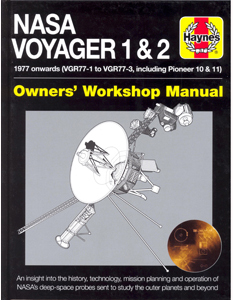Although they were launched way back in 1977, the two Voyager probes are close to the heart of many a space fan, not least because they are the most distant examples of Earth-built technology (Voyager 1 was some 20 billion km (138 AU) from the Sun by the end of 2017 and Voyager 2 was at 17 billion). This book is a heartfelt celebration of those pioneering spacecraft.
Following a foreword by Voyager Project Manager John Casani, the book is divided into a dozen sections covering everything from mission planning and launch vehicles to spacecraft subsystems and the famous ‘golden record’ (which contained a multimedia cultural ‘message from Earth’ championed by the late Carl Sagan). As with all modern Haynes Manuals, the book is well illustrated with colour photos, diagrams and facsimiles of original engineering drawings.
The section on the discovery and design of the all-important gravity propulsion trajectories that allowed the spacecraft to boost themselves past the gas giants towards the edge of the solar system is particularly good. It’s one of those stories about stubbornness, competence and hard work triumphing over the naysayers (a situation faced by the inventor/discoverer of gravity propulsion, Michael Minovitch).
Another key section is chapter 8 on the Golden Record, which was “based on the design of an LP” [long-playing record] and contained “almost two hours of audio analogue recordings and encoded pictures”. Each record came complete with a stylus, ceramic phono cartridge and instructions on how to play it. Along with these instructions, the chapter includes the text of the greetings messages, a full list of the 122 images (with thumbnails) and other details of languages and music on the Record. As Casani writes in his foreword, “We knew that it was unlikely that [an] alien culture would chance upon either Voyager, but what the record said about us was more important”. It challenged people to think about how we’d communicate with that culture and what we’d say about our own.
This is without doubt one of the best books on the Voyager missions. It’s a great pity that one of the three authors couldn’t find time to compile an index, which would have made it so much more useful, but that should not detract too much from a good telling of a great story.
Mark Williamson, Space Technology Consultant











